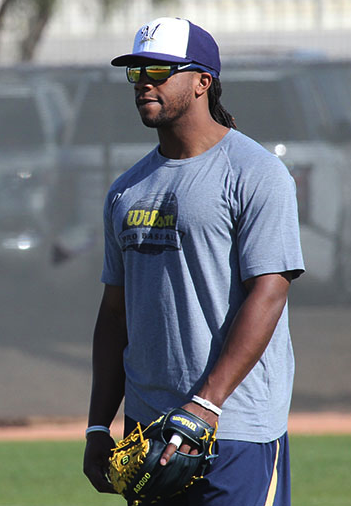Rickie Weeks going to the Mariners yesterday moved a lot of eyebrows, raising some, furrowing others. Weeks’s deal will be worth $2 million for one year, according to Jim Bowden. To the casual fan, this move might seem a little unnecessary: Seattle already has a pretty good second baseman in Robinson Cano. If you take a closer look, however, there are some hidden metrics that would point to Weeks having a resurgence.
Let’s first look at this acquisition from the position of the casual fan. Weeks is coming off a 2014 season wherein he only had 286 plate appearances, and saw a substantial reduction in power. Long story short, Weeks was a singles hitter last year. In those 286 trips to the plate, Weeks had 41 singles. In 2013, Weeks had 42 singles in 113 more plate appearances. While this helped his overall batting average get back on track, from .209 in 2013 to .274 in 2014, it did nothing to increase his power numbers.
Weeks is also a below-average fielder. Scratch that, Weeks is the worst fielder at the second base position in all of baseball, and he has been for some time now. If we are going by FanGraphs’s UZR, Weeks has a career total UZR of -56.5 for his career. That puts Weeks right at the bottom as far as second baseman who have played more than 5,000 innings since 2005 (Week’s first full season). Below are the bottom five second baseman according to UZR in that same time frame. Recognize anyone?
Notice that current Seattle second baseman Robinson Cano is four from the bottom. This really doesn’t tell us anymore than that Seattle does not put a premium on defense, and we might have suspected this all along if we had first taken a look at team UZR from the last two seasons.
There we have it. A match made in heaven. It is no coincidence that two of the bottom five defensive teams over the last two years contained two of the bottom five defensive second basemen, in Cano and Weeks. So what does this all have to do with Seattle and their recent free-agent acquisition of Mr. Weeks?
Ceteris paribus. All other things being equal, meaning if we take defense out of the evaluation (because Seattle is not focusing on defense at the time), we can better understand what Seattle saw in this now 32-year-old utility man.
Our answers lie within the batted ball statistics. Over his career, Weeks has had a fly ball percentage of 35-36% consistently. Even in 2013 it was 32.7%. Last season that percentage sunk dramatically to a career low of 25%. This may or may not be a bad sign. We will come back to the fly ball percentage shortly. Now let us look at the HR/FB ratio statistic.
Last season Weeks saw a spike in his HR/FB ratio. It reached an all time high of 17.8%. His career average for that metric is 14%. Knowing that his fly-ball percentage was at an all time low, with his HR/FB ratio at an all time high we can reasonably expect those two metrics to meet somewhere in the middle this upcoming season.
There is one last measurement we should look at in order to fully understand Weeks’s value possibility. Jeff Zimmerman and Bill Petti, of FanGraphs fame, run their own website, baseballheatmaps.com, where one can look at batted-ball distance for any player going back to 2007. When we look at Rickie Weeks, we see that he has a career average fly-ball distance of 292 feet. Last year, his average fly-ball distance was 285 feet. This slight decline is understandable due to the age factor. Weight this how you wish, but it doesn’t seem like Weeks is going through any more of a power decline than other professionals have gone through at his age.
Putting it all together, if Weeks starts to hit more fly balls, and (if nothing else) maintains his career average HR/FB ratio, the Mariners will reap the full value of his services. His defense is subpar at best, but Seattle does not seem too concerned about that. Right-handed power seems to be scarce at the moment, especially at the second base position. Rickie will add depth to Seattle, but the real value might come during the season when teams start looking for power to boost their playoff lineups—that is, if Weeks can deliver.
Next post: The Season Preview Series, Part 4 : The Kansas City Royals in a BoxPrevious post: The Season Preview Series #3: The Colorado Rockies in a (Sad) Box









steve anders
Rhetorically one has to ask why a team signs Weeks to play OF when he basically told his manager last year to kiss off while his team was fighting for a pennant. But to get paid, he is ready to play OF.
Type of guy I want on my side…..not.
Ivan
Weeks looks to be the 25th man on the roster Either he hits in April/May or he is gone. So it’s no big deal. It’s only money.